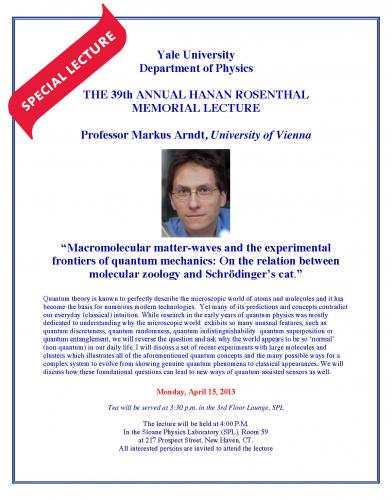
The Yale Physics 39th Annual Hanan Rosenthal Memorial Lecture was given on April 15, 2013 by Professor Markus Arndt, University of Vienna.
Monday, April 15, 2013 - Macromolecular matter-waves and the experimental frontiers of quantum mechanics: On the relation between molecular zoology and Schrödinger’s cat
Quantum theory is known to perfectly describe the microscopic world of atoms and molecules and it has become the basis for numerous modern technologies. Yet many of its predictions and concepts contradict our everyday (classical) intuition. While research in the early years of quantum physics was mostly dedicated to understanding why the microscopic world exhibits so many unusual features, such as quantum discreteness, quantum randomness, quantum indistinguishability quantum superposition or quantum entanglement, we will reverse the question and ask why the world appears to be so ‘normal’ (non-quantum) in our daily life. I will discuss a set of recent experiments with large molecules and clusters which illustrates all of the aforementioned quantum concepts and the many possible ways for a complex system to evolve from showing genuine quantum phenomena to classical appearances. We will discuss how these foundational questions can lead to new ways of quantum-assisted sensors as well.
The Hanan Rosenthal Memorial Lecture was established in honor of physicist Hanan Rosenthal, a brilliant graduate student at Columbia University and instructor at Yale. This annual lecture in atomic physics, Rosenthal’s field, is given by a distinguished leader in the field. Originally, the lecture series alternated between Columbia and Yale, which were both significant in Hanan Rosenthal’s career; in recent years, the lecture has been held only at Yale University.